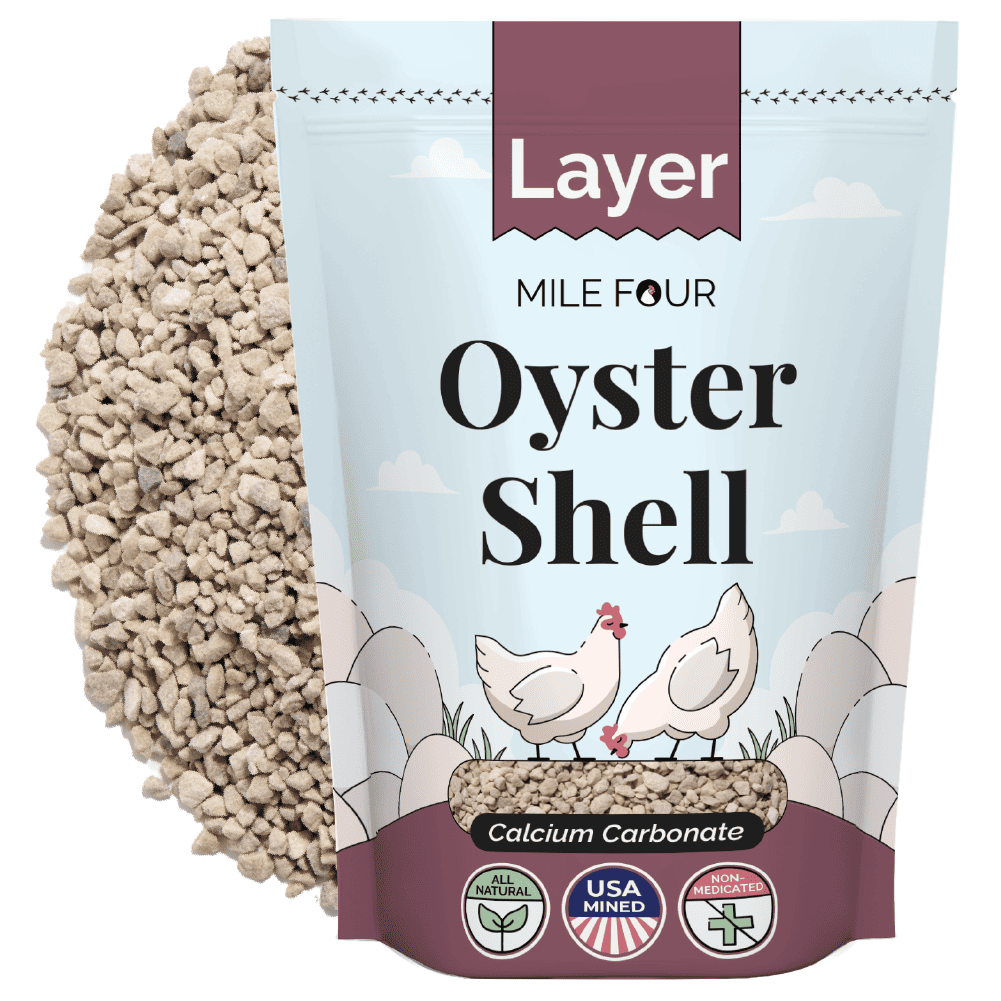Quick Plymouth Rock Chicken Facts
| Origin | United States |
| Colors | Blue, white and black |
| Weight | 7 - 8 lbs. |
| Lifespan | 10 - 12 yrs. |
| Rate of Lay/yr. | 180 - 240 eggs |
| Egg size | Large |
| Egg Color | Brown |
| Heat Hardy | Yes |
| Cold Hardy | Yes |
| Broodiness | Infrequent |
| Disease Susceptibility | None |
| Temperament | Calm |
| Beginner friendly | Yes |
| Cost to purchase | $4.50 |
Quick Jump
Chapter 1: Appearance of Plymouth Rock Chickens
Chapter 2: History of Plymouth Rock Chickens
Chapter 3: Plymouth Rock Chickens for Sale
Chapter 4: Plymouth Rock Chicken Egg Laying
Chapter 5: Plymouth Rock Chicken Health Issues & Care
Chapter 6: Plymouth Rock Chicken Temperament
Chapter 7: Feeding Plymouth Rock Chickens
Chapter 8: Coop & Run Size for Plymouth Rock Chickens
Chapter 9: Pros & Cons of Plymouth Rock Chickens
Chapter 10: Plymouth Rock Chicken FAQs
Chapter 1: Appearance of Plymouth Rock Chickens
Plymouth Rocks are beautiful, sturdy and heavy chickens that have a full breast and a long, slightly curved back.
They have a yellow beak that is the same color as their legs and feet, while their combs and lobes are a beautiful bright red.
Plymouth Rock Chicken Size
A standard Plymouth Rock hen will weigh around 7 or 8 lbs., meaning they’re quite a large bird compared to some other backyard favorites.
A rooster will potentially weigh up to 10 lbs.
There is a bantam variety of Plymouth Rocks too, where the hens weigh around 2.5 lbs. and the males weigh around 3 lbs.
Colors
There are currently three recognized colors for the Plymouth Rock chicken.
- Barred
- White
- Buff
The most popular is the barred Plymouth Rock, the one you’re most likely to see when purchasing the breed for your backyard.
There are other variations you might see, but they are much more rare than the barred rock.
These are:
- Colombian
- Buff Colombian
- Blue Laced
- Silver Partridge
The Barred Rock variety was the most popular chicken in the United States for the majority of the early 1900’s, and is still very popular to this day.

Share this Image On Your Site
Chapter 2: History of Plymouth Rock Chickens
The Plymouth Rock’s history is a little murky.
The chicken first popped up in Massachusetts in 1849, but was not seen again until 1869.
The chicken shown in 1869, which was bred from Black Java hens and a rooster with barred plumage, is thought to be where the modern Plymouth Rock is derived from.
Plymouth Rock Chickens Journey
The breeding goal for the Plymouth Rock was to create a chicken that had barred plumage and featherless legs.
It was only five years later, in 1874, that the Plymouth Rock was added to the American Poultry Association’s Standard of Excellence.
From this time, all the way up to World War 2, the breed was the most popular in the United States.
As the US government encouraged people to keep chickens for their eggs and meat during the war, along with industrial farming, the popularity of the Plymouth Rock began to decline.

Share this Image On Your Site
Today, the Plymouth Rock is considered a “recovering” breed, which means that more than 2,500 new Plymouth Rocks are registered every year worldwide.
It is thought that there are now more than 25,000 Barred Plymouth Rock chickens around the world.
Due to their popularity as a dual purpose breed, the White variety of the Plymouth Rock is likely the chicken you will purchase at the grocery store.
Chapter 3: Plymouth Rock Chickens for Sale
Plymouth Rock Chicken Hatcheries
Like most birds, the Plymouth Rock doesn’t seem to have hatcheries specific to the breed.
They are, however, readily available at most of the popular online hatcheries, and if you live near one you should easily be able to find them.
Each Plymouth Rock Chicken will cost around $3.50 if you purchase more than 100 birds at a time, or $4.50 if you purchase between one and five.
Availability of Plymouth Rock chickens usually starts around the end of January each year, and stretches through to October, which is quite typical of most chicken breeds at most hatcheries.
You’ll want to note that if it is your first time buying chicks online, they will be shipped to you with enough food to last the trip.
You will have to pick them up at the Post Office and have a member of staff watch you physically open the box to ensure they were delivered in good shape.
Should you have any problems with your delivery, most hatcheries will be happy to send you a replacement shipment.
If you need more information on purchasing chickens from a hatchery, read our Best Hatcheries Guide here!
Chapter 4: Plymouth Rock Chicken Eggs
Plymouth Rock Chicken Rate of Lay
The biggest reason the Plymouth Rocks have stayed popular despite their decline after World War 2 are their eggs and their egg production.
They will start to lay their eggs around 20 weeks, which is pretty standard for most breeds, and why we recommend switching to our Layer Feed right at the 20 week mark!
Each Plymouth Rock hen will lay around five eggs per week.
The eggs are large in size, around 24 ounces per dozen, and they’re a beautiful light brown.
Plymouth Rock hens will lay at this rate for at least three years, after which their egg production will start to decline.
Some Plymouth Rocks, however, have been known to lay well into their old age, some as old as 10!
Another good thing about Plymouth Rock chickens is that they will lay well into the winter months, when most birds see their egg production decline due to the weather.
This makes them a backyard favorite for anybody who can’t go a day or two without a tasty omelette!

Share this Image On Your Site
Plymouth Rock Chicken Broodiness
Despite not being known as a broody breed, if a Plymouth Rock does go broody, they will take very good care of their eggs and any chicks that hatch from them.
They have strong maternal instincts, and will look after chicks in the flock even if they aren’t their own.
You can also encourage them to become broody, should you need a mother hen for any hatching chicks that you don’t have a brooding device for.
To do this, you can purchase artificial eggs and place them in a nesting box for a period of time until the Plymouth Rock starts to sit on them.
From there, you can replace the artificial eggs with fertilized ones, or simply add the fertilized eggs into the nest.
Chapter 5: Plymouth Rock Chicken Health Issues & Care
Plymouth Rocks were bred from already healthy and sturdy chickens, so they don’t suffer from many of the ailments that other breeds do.
This is another reason why they’re so popular with backyard chicken keepers like yourself.
Since their feet and legs aren’t covered with feathers, you don’t need to worry about them getting dirty and matted together, or for things like lice and mites around there.
You should, however, routinely check their plumage for signs of this, and keep them as clean as they can be, especially when the weather gets cold and wet.
You’ll also want to give them a nice, dry patch of land that they can dust bathe in when they want, so you don’t have to do hands-on cleaning all the time.
As with any chicken, you’ll need to ensure the coop is warm enough for them in the winter months, and not too hot in the summer months.
Additionally, they can be susceptible to frostbite if not looked after, so watch out for that!
Chapter 6: Plymouth Rock Chicken Temperament
Plymouth Rocks are a docile and calm breed, which is yet another reason on the list of why they make excellent backyard chickens.
They’re very friendly with humans and children too, but if you have a rooster you may want to let it warm up to you first before allowing your children near it.
They’ve been known to be a bit temperamental when moving into their new homes.
Once your Plymouth Rock hens and roosters are established in the flock, they’ll happily be held and carried around, and enjoy receiving pets too.
They’ll also follow you around quite often, usually seeing if you have any treats to give them, but they’ll also happily garden with you, and will be the first to snap up anything that moves on the ground for food.
Plymouth Rock Chickens in the Pecking Order
Due to their sturdiness, Plymouth Rocks will likely find themselves in the middle of the pecking order in your flock.
Despite this, they are highly unlikely to pick on any of the members who are lower down.
They shy away from any conflict, and will likely be on the outskirts of any skirmishes that happen between your chickens.
They’ll also get along with nearly all of the chickens in your flock, as well as your family and friends!
Chapter 7: Feeding Plymouth Rock Chickens
Plymouth Rock chickens don’t have any specific dietary needs, meaning you’ll be fine feeding them what you feed the rest of your flock.
Chicks will need a 21% Starter Feed, which you can purchase right here! They will eat Starter from the day they’re born until they are around 8 weeks old.
Once they’re 8 weeks old, you’ll want to switch them to a 18% Grower Feed, which you can also purchase right here!
Grower is fed to pullets from 8 weeks all the way up to when they lay their first egg.
Once their first egg is laid, you’ll need to switch them to a 16% Layer Feed.
You guessed it. You can purchase Layer Feed right here!
This Layer Feed will be the main source of nutrition for the rest of their lives, but you can add in treats like Scratch, or Oyster Shell to aid in egg production.
Chapter 8: Coop & Run Size for Plymouth Rock Chickens
Since they are larger chickens, Plymouth Rocks will need more than the average space for chickens.
A coop that is 4 ft. x 4ft. per Plymouth Rock should be sufficient. Any less than that can encourage some bad behavior as they fight for space.
Other than the added coop space, you should be able to keep everything else inside the coop standard.
A 10 in. roosting space per bird is preferred, along with a 12 in. x 12 in. nesting box.
Their roosting space can be bigger than 10 inches, as they will enjoy spreading out in the summer months to keep cool.
You won’t need a nesting box per chicken, either. One nesting box per every three birds will be more than fine for your flock.
Chapter 9: Pros & Cons of Plymouth Rock Chickens
| Pros | Cons |
| Calm & docile temperament | Susceptible to frostbite |
| Good with children | May only lay for 2-3 years |
| Great layers | Need plenty of shade in the summer |
| Stay out of trouble for the most part | May have to build a bigger coop |
| Quiet birds | Can be bullied, or be bullies - but not often |
Chapter 10: Plymouth Rock Chicken FAQs
Q: How many eggs will a Plymouth Rock hen lay per year?
A: Plymouth Rocks will lay more than 200 eggs per year
Q: What color are Plymouth Rock chicken eggs?
A: Their eggs are a beautiful light brown
Q: Are Plymouth Rock chickens aggressive?
A: Nope! They’re a docile, calm and friendly breed, just make sure they have enough space inside the coop
Q: How often do Plymouth Rock hens go broody?
A: Not often at all, but it can be encouraged with artificial eggs
Q: Are Plymouth Rock chickens susceptible to any diseases?
A: Not really, but you will want to give them a dry space for dust bathing, and ensure they aren’t exposed to cold weather for too long or they’ll get frostbite
Summary
Probably the most ideal bird for a backyard flock, the Plymouth Rock is friendly, a family favorite, and lays a lot of beautiful eggs!
They are bigger than the average breed, which means you will have to expand your coop or start fresh.
You’ll also need to make sure they stay warm in the winter months and aren’t exposed to the elements, as they are susceptible to frostbite.
Overall, though, they will provide you with their eggs and company for quite some time, and become a great pet for your backyard flock!




![Winter Chicken Care | Ultimate Guide [2026]](http://milefour.com/cdn/shop/articles/Mile_Four-Content-15_e1067340-1a72-4632-83f5-c66d9a2158d9.png?v=1768418185&width=1500)





2 comments
How upsetting this must be. It sounds like your Barred Rock must have developed some type of mental illness. I would rehome her. Or give her to a Halal butcher. I recommend a Halal butcher because of their respectful attitudes toward animals being killed for food. If you have any Halal grocery in your area, check there. We just got the same Eglu coop and our 4 chicks, including a Barred Rock, are coming in March! I know you care for all your hens and this is tough, but you have to think of your flock. If you had a rooster, he would not permit the BR hen to do this to his hens. Good luck!
I have a small 8 hen flock with different layer breeds (Wyandotte, Blue Sapphire, New Hampshires, Cuckoo Maran, & 3 PlymouthRocks -2 white, 1 barred.) They are in a Omlet Eglu brand coop in a 9×12 run and they free range several hours a day. Recently the barred Rock started very aggressively going after 3 other hens, 1 in particular who now runs from all the others and spends most of the day on top of the coop. It hasn’t been typical pecking order behavior but more abusive in nature. He has been pulling feathers off the others. I separated the barred Rock in a dog crate for 4 days and reintroduced her back in. She was fine for about 2 hours before getting aggressive again. She cornered a white Rock and pushed her head to the ground. Then she went after the New Hampshire and held her down and started picking at her comb. So I have separated her again. The flock is calm when she is separated and appear on edge when she is with them. I may have to give her away. I considered getting a water pistol to squirt her when I observe bad behavior but I can’t be watching them all day. Is this type of aggressiveness normal for a barred Plymouth Rock? All hens are 6 months old and grew up together from day one.Thank you for any comments/advice.